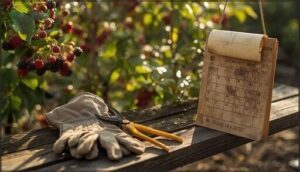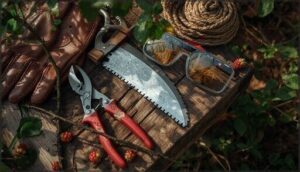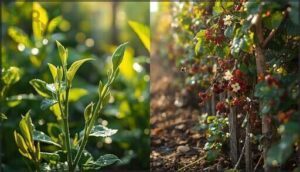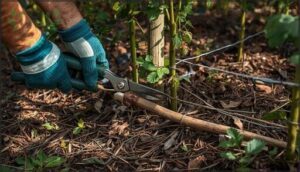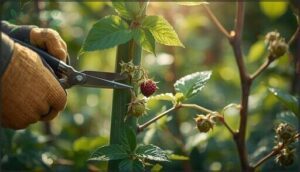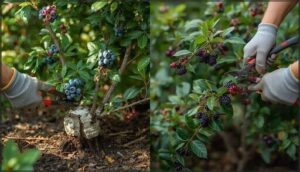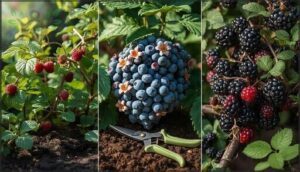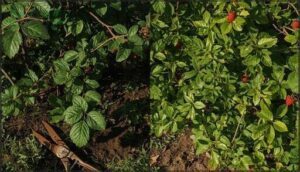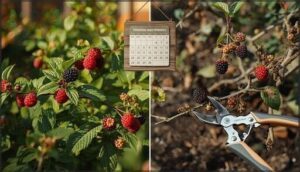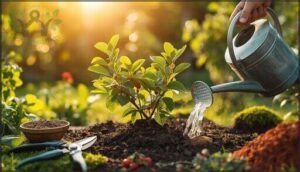This site is supported by our readers. We may earn a commission, at no cost to you, if you purchase through links.

Most gardeners either attack their bushes with abandon or tiptoe around them nervously, both approaches costing them the abundant harvests they’re after.
Understanding when to cut, where to cut, and which canes to spare transforms struggling plants into productive powerhouses that deliver basket after basket of plump berries year after year.
Table Of Contents
- Key Takeaways
- Why Pruning Matters for Berry Plants
- Best Time to Prune Berry Bushes
- Essential Tools and Safety for Pruning
- Pruning Techniques for Cane Fruits
- How to Prune Blueberries and Elderberries
- Pruning Berry Bushes by Type
- Common Pruning Mistakes to Avoid
- How Often to Prune Berry Plants
- Post-Pruning Care and Maintenance
- Frequently Asked Questions (FAQs)
- Should berry plants be pruned?
- How to tip prune berry bushes?
- How do you prune a berry cane?
- How often should berry bushes be pruned?
- How do you prune a berry tree?
- What happens if you prune berry canes too often?
- Can you prune berries in hot summer weather?
- Do thornless varieties require different pruning methods?
- How does soil type affect pruning decisions?
- Should you prune newly planted berry bushes?
- Conclusion
Key Takeaways
- Pruning timing is critical—dormant season cuts (late winter to early March) maximize vigor and healing, while understanding whether your variety fruits on first-year primocanes or second-year floricanes determines your entire cutting strategy.
- Over-pruning can slash yields by over 100% in some varieties, while under-pruning shrinks berries by 19-27% and doubles disease risk, making moderate, targeted cuts essential for balancing fruit production and plant health.
- Clean, sharp tools aren’t optional—dull blades slow wound healing by 30% and dirty equipment spreads pathogens that can cut yields by 15-25%, so disinfect between plants and sharpen regularly.
- Each berry type demands its own approach: blackberries and raspberries need spent floricanes removed at ground level after harvest, while blueberries thrive when you thin out canes older than three years and elderberries respond to either selective removal or complete coppicing.
Why Pruning Matters for Berry Plants
Pruning does a lot more than tidy up your berry patch. It helps your plants stay strong and sets the stage for the best harvest possible.
Here’s what pruning can do for your berries.
Benefits for Plant Health
Think of pruning as plant health management—the gardener’s secret for sturdy, resilient berry bushes. By removing diseased wood and thinning crowded canes, you cut pest pressure, boost disease resistance, and drive vigor increase right where it counts.
Targeted cuts encourage new root development while freeing up resources; that helps get the most out of nutrient absorption, weaving the lasting benefits of pruning into every season’s growth.
Pruning helps manage biennial cane growth in blackberry plants.
Maximizing Fruit Yield and Quality
Careful pruning isn’t just a chore—it’s plant health management that pays you back with better fruit. Well-timed cuts help direct energy into berry production, heighten yields, and give you plumper, sweeter fruit.
Matching pruning intensity to cultivar needs, balancing carbohydrate allocation, and optimizing timing all shape both the quality and quantity of your harvest, making each cut count.
Research is being conducted to refine selective pruning techniques for blueberry plants.
Disease and Pest Control
Once you’ve set the stage for high-quality fruit, pruning becomes your best ally for disease and pest control. Timely cuts paired with tool sanitation slash the risk of fungal outbreaks and bacterial spread.
Thinning canes and improving airflow benefits plants by drying wet leaves faster, while smart pruning timing and technique help reduce pest habitats—making disease prevention a hands-on, ongoing routine.
Best Time to Prune Berry Bushes
Choosing the right time to prune your berry bushes makes all the difference in how they grow and fruit. Timing depends on your climate, the type of berry, and what you want for next year’s harvest.
Here’s what you’ll want to know before you start reaching for your pruners.
Dormant Season Vs. Growing Season
Ever notice how plants rest in winter, saving energy underground? Dormant season pruning benefits your berry bushes most—wounds heal fast, vigor surges, and you set the tone for growth come spring. Pruning effects during active growth, though, can sap strength and disrupt schedules. For the best results, time your cuts:
- Get the Most Out of Dormant benefits
- Improve Vigor management
- Fine-Tune Growth impact
- Improve Seasonal timing
Fall Pruning Pros and Cons
When fall pruning finds its mark, you gain real benefits: Dormancy Preparation sets roots up for spring, while smart thinning aids Disease Prevention. Yet, premature cutting risks Winter injury and drains energy, especially for cane fruits. Results hinge on Species Variation, too.
Used right, fall berry pruning can boost Labor Efficiency—just don’t rush the process before natural dormancy.
Climate and Zone Considerations
When you time your pruning, take Zone Hardiness and Chilling Hours into account. Some plant varieties wake from dormancy early, while others linger, especially in warmer growing seasons.
In zone 5 and colder, prune during dormancy for frost protection and less Winter injury. Tropical adaptation calls for late-season work and careful seasonal adjustments to dodge heat stress and improve yield.
Essential Tools and Safety for Pruning
Before you start pruning, make sure you have the right tools and know how to stay safe. The gear you use and how you handle it can make a big difference for both you and your plants.
Here’s what you’ll want to have on hand before getting to work.
Choosing The Right Pruning Tools
Successfully pruning berry plants begins with knowing your tools. For live branches, sharp bypass pruners or shears prevent damage, while anvil pruners work better for deadwood. Lopper lengths help reach dense thickets, and a pruning saw tackles thicker wood. Pole pruner reach—and even electric pruners—make tall or tough spots manageable, rounding out your effective pruning tools and equipment.
Protective Gear for Safe Pruning
What’s standing between you and a berry bush full of thorns? The right protective gear is your first line of defense. Glove materials matter—opt for cut-resistant styles. Prioritize protective eyewear to keep flying debris at bay. And remember, full body coverage and hearing safety can make all the difference, especially as you handle sharp clean shears and other pruning tools and equipment.
- Cut-resistant gloves shield your hands from thorns and branches
- Protective eyewear stops sap and debris before it reaches your eyes
- Long sleeves and stable boots protect skin and give you confidence as you move through tangled canes
Tool Cleaning and Maintenance
Sharp, clean shears aren’t just a preference—they’re essential for disease prevention. After each use, wash your pruning tools with warm soapy water and dry them within an hour.
Disinfection methods like 70% alcohol kill pathogens between cuts, reducing fungal risks. Remove rust with vinegar, then apply light oil for protection.
Regular sharpening and proper storage practices keep your equipment performing season after season.
Pruning Techniques for Cane Fruits
Cane fruits like blackberries and raspberries need a different approach than bush berries. The key is understanding whether your variety fruits on first-year canes or second-year canes.
Let’s break down the techniques that’ll keep your cane fruits productive year after year.
Primocane Vs. Floricane Varieties
Understanding cane growth makes pruning canes far more effective. Primocanes are first-year shoots that grow vigorously throughout the season, while floricanes are second-year canes that produce fruit before dying back.
Floricane varieties fruit once in summer, then you’ll remove them post-harvest. Primocane types let you cut everything to ground level when dormant, simplifying disease resistance and making your job easier each spring.
Step-by-Step Cane Removal
Now you’re ready to take action. Start by identifying three to eight vigorous main canes per plant—healthy, upright growth you want to keep. Remove dead canes and spent canes completely at ground level right after harvest, using clean cutting techniques to prevent disease spread.
Thin out weak or horizontal shoots, then secure your selected canes to the trellis for support. Monitor regrowth over the following weeks to catch any issues early.
Tip Pruning for Better Growth
Once your main canes are secured, tip pruning gives you real control over plant growth. When primocanes reach 4–5 feet tall in early summer, remove the top 2–3 inches.
This pruning technique triggers lateral branching—you’ll see 10–14 fruit-bearing laterals develop per cane instead of just 4–6. The result? A yield increase of up to 25% and better disease prevention through improved airflow.
How to Prune Blueberries and Elderberries
Blueberries and elderberries need a different approach than cane fruits. These bush-type berries grow on woody stems that last several years, so you’ll focus on thinning out old wood rather than cutting everything to the ground.
Let’s look at how to prune each one for the best fruit production.
Timing for Blueberry Pruning
Timing blueberry pruning correctly unlocks higher yields and healthier plants. You’ll want to prune during dormancy—generally January through early March—when buds haven’t swollen yet and carbohydrate reserves have moved to the roots. Regional variations matter: southern growers in Zones 8–9 can prune after harvest, while northern climates (Zones 3–5) benefit from late-winter scheduling practices to avoid frost damage.
- Winter pruning boosts yield by 168% compared to summer cuts, according to recent studies
- Dormancy pruning protects bud development formed the previous fall
- Proper timing increases fruit size and prevents the 32% reduction seen with delayed pruning
- Late-winter scheduling allows you to spot winter-injured wood easily
Techniques for Elderberry Pruning
Elderberries respond well to two main approaches: selective cane removal or coppicing. You can trim elderberry bushes by cutting canes older than three years to ground level—this keeps pruning frequency manageable and maintains cane balance with six to eight productive stems.
Coppicing methods involve removing all growth annually, syncing fruit ripening but slightly reducing yield. Always sterilize tools between cuts, and note that cultivar differences affect how American versus European elderberries handle aggressive pruning techniques.
Managing Vigorous and Weak Varieties
Your pruning strategy should shift dramatically based on plant vigor. Vigorous varieties handle lighter thinning—remove just 10% to 15% of the largest and weakest canes annually. Weak varieties need aggressive culling of damaged stems, keeping only a few strong canes per plant.
Vigor Assessment and Pruning Intensity Guidelines:
- Vigorous blueberries: Head strong canes 4-6 inches below summit; thin crown by 20% annually
- Weak berry varieties: Cull small, damaged canes aggressively; retain only strongest stems
- Cane Retention: Keep 4-5 canes for raspberries, 8-10 for blackberries
- Rejuvenation Pruning: Cut all canes back on neglected weak bushes to force new growth
- Varietal Differences: Replace weak plants if recovery fails despite intensive pruning
Pruning Berry Bushes by Type
Each type of berry bush has its own growth pattern and fruiting habit, which means your pruning approach needs to match the plant. What works for a raspberry won’t necessarily work for a currant, and blackberries demand their own specific technique.
Let’s break down the pruning methods for the most common berry types so you can give each plant exactly what it needs.
Blackberry Bush Pruning
You’ll prune blackberry bushes annually to maintain healthy cane management and strong yields. Cut old floricanes to the ground right after harvest to eliminate disease reservoirs and pruning wounds that harbor pests.
During summer, tip primocanes at 42 inches to encourage lateral branching—this double cropping method boosts fruit production considerably.
Leave 3 to 6 vigorous new canes per plant, considering varietal differences and cane training needs for best blackberry bush pruning results.
Raspberry Pruning Guide
Red raspberries need pruning in early spring before buds swell, usually late March to early April. Floricanes fruit on one-year-old canes—cut these to ground level after harvest.
Primocanes benefit from mowing to ground level each winter for better disease prevention and yield optimization.
Maintain 4 to 6 canes per linear foot, spacing them 6 inches apart for ideal cane management and variety differences.
Currant, Boysenberry, and Cranberry Tips
Each of these berry bushes has unique pruning needs that can make or break your harvest. Understanding the differences helps you get the best results.
- Currant stem count: Keep 8–15 stems total, with 4–6 from each age class (1-, 2-, and 3-year-old wood). This balance maximizes yield improvements while ensuring disease prevention through better airflow.
- Boysenberry floricanes: Cut spent second-year canes to ground level right after harvest. Leave only 4–6 strong first-year canes for next season’s fruit.
- Cranberry anthocyanin: Heavy pruning boosts berry color but reduces immediate yield. Plan for a two-year recovery cycle.
- Disease prevention: Remove old wood promptly to minimize overwintering pests and fungal infections in all three berry types.
Common Pruning Mistakes to Avoid
Even experienced gardeners can make pruning errors that hurt their berry plants instead of helping them. The good news is that most mistakes are easy to avoid once you know what to watch for.
Let’s look at three common pruning pitfalls and how you can steer clear of them.
Over-Pruning and Under-Pruning
Getting the balance right can feel like walking a tightrope. Over-pruning slashes your yield—some blueberry varieties dropped by 102% when pruned too aggressively. Under-pruning creates its own headaches: berries shrink 19–27% in weight, disease incidence climbs, and picking efficiency plummets by half.
Both extremes hurt resource allocation and long-term plant vigor, so aim for moderate, thoughtful cuts that renew without shocking your bushes.
Ignoring The Branch Collar
Skipping that swollen ridge at the branch base invites disaster. The branch collar shields your plant from infection, and ignoring it triggers faster decay, slower wound healing, structural weakness, higher pest incidence, and reduced longevity. Proper pruning techniques respect this zone:
- Locate the collar – it’s the bulge where branch meets trunk
- Cut just outside it – don’t slice flush
- Preserve protective tissue – your plant’s natural defense
- Avoid common pruning mistakes – study pruning methods first
Using Dull or Dirty Tools
Just as critical as respecting the collar is working with sharp, clean equipment. Dull blades tear canes instead of slicing cleanly, slowing wound healing by up to 30% and inviting disease transmission. Dirty tools spread pathogens from plant to plant, cutting yields by 15–25%. Sanitation practices matter: dip pruners in 10% bleach or 70% alcohol between cuts, sharpen blades regularly, and follow industry recommendations for disease control.
| Problem | Impact on Plant Health | Prevention Strategy |
|---|---|---|
| Dull blades | Jagged cuts, 30% slower healing, dieback | Sharpen before each session |
| Dirty tools | Disease transmission, canker outbreaks | Disinfect between plants |
| Soil residue | Fungal and bacterial spread | Clean with bleach solution |
| Unmaintained equipment | Reduced yield (15–25%), poor fruit quality | Routine maintenance protocols |
| Skipped sanitation | Viral pathogens, pest incidence | Multiple tool sets for rotation |
How Often to Prune Berry Plants
You might think all berry plants need pruning on the same schedule, but that’s not quite how it works. Some berries demand annual attention, while others can go longer between sessions.
Let’s break down how to tell when your plants need a trim and what happens if you wait too long.
Annual Vs. Biennial Pruning Needs
While annual pruning remains the standard for most berry plants, you should understand that biennial systems offer trade-offs worth considering. Biennial approaches reduce labor expenses and work well for floricanes in trailing blackberries, though they yield about 75% compared to annual systems.
Annual pruning of blueberries boosts berry size by up to 27% and maintains cane vigor, but it accounts for 30% of production costs. Regional differences and disease impact influence which pruning techniques suit your needs best.
Signs Your Plant Needs Pruning
Your berry plants show clear signals when they’re overdue for pruning. Watch for reduced fruit size—unpruned blueberries can produce berries 19–27% smaller. Excessive cane density creates poor airflow and increases fungal disease by 40% in raspberry stands.
Look for diseased wood, imbalanced structure, or reduced vigor, like fewer than two new canes yearly in blueberries. These signs mean it’s time to restore plant health through proper pruning techniques.
Effects of Skipped Pruning
When you neglect pruning, yield reduction hits hard—unpruned plots show up to 51% lower harvests over time. Quality decline follows, with smaller berries and increased disease susceptibility from poor airflow.
Structural imbalance worsens as old canes crowd out new growth, cutting photosynthetic efficiency by 40%.
These sustainability effects compound yearly, threatening plant health and shortening your berry bushes’ productive lifespan by several years.
Post-Pruning Care and Maintenance
Pruning your berry plants is just the beginning—what you do afterward matters just as much. The right care immediately following pruning helps your plants recover quickly, encourages strong new growth, and sets the stage for a productive season ahead.
Let’s walk through the essential steps to keep your freshly pruned berry bushes thriving.
Supporting Pruned Plants
After pruning, your berry plants need structural support to channel their energy into healing and new growth. Install stakes or trellises to guide canes upward—trellis systems improve airflow and reduce breakage by over 40%. Weaving canes through wires prevents wind damage and speeds plant recovery.
Add mulch around the base to stabilize roots and boost moisture retention, essential for postpruning care and long-term root health.
Watering and Fertilizing After Pruning
Right after you prune, water deeply to help plant recovery—mature blueberries need 1.5 to 3 inches per week, while raspberries thrive with 1 to 2 inches. Drip systems, applied three times weekly, boost nutrient uptake and growth effects.
Apply fertilizer once soil moisture stabilizes; delaying until autumn increases nitrogen recovery by 5.5 pounds per acre, fueling strong postpruning care.
Monitoring for Pests and Disease
Weekly scouting catches trouble early—blueberry maggot can damage 10-25% of crops if you miss the signs. Use yellow sticky traps and digital monitoring for real-time alerts, then apply IPM strategies and biological controls when trap counts spike.
Disease forecasting apps help you time sprays perfectly, cutting fungicide use by 20%.
Trap technologies and plant care routines keep your pruned bushes thriving, ensuring strong plant health and effective disease and pest control.
Frequently Asked Questions (FAQs)
Should berry plants be pruned?
Think of your berry plants like a team: only the strongest players produce winning results. Pruning is essential for plant vigor, maximizing fruit yields, and disease resistance.
Pruning is essential—it strengthens plant vigor, maximizes fruit yields, and builds disease resistance like a team keeping only its strongest players
It dramatically improves plant health while boosting fruit production and quality.
How to tip prune berry bushes?
Tip pruning canes for berries means cutting back branch tips during summer pruning to encourage lateral growth. Use sharp tools and make 45-degree angle cuts.
Consider varietal differences—timing tips matter for primocane versus floricane varieties.
How do you prune a berry cane?
You’ll want to prune berry canes based on their type. For floricanes, remove spent canes at ground level after harvest.
For primocanes, thin to four-to-six canes per foot, then tip prune when they exceed five feet.
How often should berry bushes be pruned?
Most berry bushes need annual pruning during their dormant period, usually late winter or early spring.
Your pruning schedule depends on berry type, growth stage, fruiting habits, and regional climate considerations.
How do you prune a berry tree?
As the saying goes, “prune hard to grow strong.” You’ll need sharp pruners to remove dead or damaged canes, thin overcrowded growth, and cut spent floricanes to ground level, promoting vigorous new fruiting wood and peak plant health.
What happens if you prune berry canes too often?
Overpruning severely weakens plant vigor and reduces yield, compromising fruit quality. Stress recovery slows, pest susceptibility increases, and management challenges multiply.
A balanced pruning strategy is essential for maintaining fruit production and improving fruit yield long-term.
Can you prune berries in hot summer weather?
You can prune berries in summer, but timing adjustments and shading techniques matter. Heat stress risks increase above 85°F, so prune early morning or evening.
Maintain irrigation strategies and watch humidity considerations to avoid disease.
Do thornless varieties require different pruning methods?
While thornless blackberries follow similar pruning techniques as thorny types, their erect growth habit simplifies training since they don’t need trellising.
You’ll find tip pruning and cane removal easier without dealing with thorns.
How does soil type affect pruning decisions?
Soil pH directly influences nutrient uptake—blueberries in highly acidic soil absorb micronutrients 20-30% more efficiently.
Poor root health from compacted earth weakens plant growth, requiring you to prune diseased canes and reduce stress through strategic fertilizer programs.
Should you prune newly planted berry bushes?
Yes, but initial pruning varies by berry type. Raspberries and blackberries benefit from cutting back canes to encourage root development and plant establishment.
Blueberries need flower bud removal to prioritize growth encouragement during their first year.
Conclusion
Picture your berry bushes next summer: branches heavy with fruit, leaves gleaming with health, no tangled canes choking out production. That vision becomes reality when you apply this berry plant pruning guide with confidence and consistency.
Your shears aren’t just cutting wood—they’re directing energy, preventing disease, and unlocking the genetic potential sleeping in every cane.
Master these techniques, and your bushes will reward you with harvests that fill freezers and satisfy cravings season after season.
- https://horticulture.oregonstate.edu/sites/agscid7/files/horticulture/attachments/37_strik_et_al_pruning_severity_blueberry_hs_2003.pdf
- https://utia.tennessee.edu/publications/wp-content/uploads/sites/269/2023/10/SP284-E.pdf
- https://extension.psu.edu/pruning-blueberries-in-home-fruit-plantings/
- https://ohioline.osu.edu/factsheet/hyg-1430
- https://journals.ashs.org/view/journals/horttech/35/6/article-p865.xml

